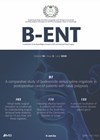
Journal Reviews archive for March 2022
Moving towards implanting children below 12 months of age
Newborn hearing screening has ensured that deaf infants are identified soon after birth so that habilitation can begin as early as possible. Cochlear implantation is a key component of early intervention for some children, but it is often not performed...
Gastrostomy tube dependence following TORS
Transoral robotic surgery (TORS) for oropharyngeal squamous cell carcinoma (OPSCC) is now a well-established treatment modality for early (T1-T2) disease. Accumulating evidence suggests that one of its main benefits relative to conventional chemoradiotherapy is superior long-term functional outcome, especially with...
Why do some people get their smell back so quickly after a COVID infection whilst others don’t?
Of course, we are all too familiar with the effect that COVID-19 infection has on our sense of taste and smell, but why do most patients get better whilst, for many, the misery lingers on and on? This paper looks...
Vestibulo-ocular reflex and postural control in deaf children
The authors evaluated the impact of canal paresis detected by video head impulse test (vHIT) on postural control tested by platform posturography in children with sensorineural hearing loss. The study included 55 children (4-16 years old) with variable degrees of...
Are quinsies worth draining?
Recent data is providing accumulating evidence that treatment failure in the management of peritonsillar abscesses (PTAs, aka ‘quinsies’) is similar when these are managed with medical treatment (MT) alone versus MT plus surgical drainage (M+ST). However, in the absence of...
Role of intratympanic corticosteroid for treatment of Bell’s palsy and Ramsay Hunt syndrome
Acute peripheral facial palsy occurs annually in 30 in 1,000,000 individuals in the general population. Bell’s palsy and Ramsay Hunt syndrome account for about 70% of cases of peripheral facial palsy. They are believed to be caused by viral reactivation...
Septoplasty under local and general anaesthetic
This Turkish prospective, non-randomised study compared the quality of life outcomes in 50 patients who underwent local anaesthetic (LA) septoplasty, and 50 patients who underwent general anaesthetic (GA) septoplasty over a six-month period. Quality of life outcomes were measured using...
Treatment options for vestibular neuritis: systematic review and meta-analysis
Vestibular neuritis (VN) is the third most common cause of peripheral vertigo. VN has been postulated to have viral aetiology and historically it was treated with steroids, until 2011 when a Cochrane review demonstrated lack of robust evidence behind this...
Predicting the nature of swallowing deficits caused by surgical resection of the tongue?
Patients treated surgically for cancer of the tongue are expected to have difficulty in eating, drinking and swallowing. The authors of this paper report on a cohort of 106 patients in their practice who had surgical resection as primary treatment....
Loudness in non-organic hearing loss
Non-organic hearing loss has been of interest to researchers for a long time. In this study the authors compared a loudness rating measured in relation to the sound level for 1000 Hz in normal hearing patients and patients diagnosed with...
Speech predictors after glossectomy
This is a cross-sectional study from India where 69 patients were assessed for speech intelligibility and phonetics using an assessment tool in the local language. Volume defects were classified into thirds and the location of this defect noted. Not unsurprisingly,...
Cochlear implantation in asymmetric hearing loss
Criteria for cochlear implantation (CI) is a constant topic of debate. The UK traditionally had relatively restrictive guidance, although this has been greatly improved by more recent guidance released in 2019. Nevertheless, because of the lack of evidence for cost-effectiveness,...

















